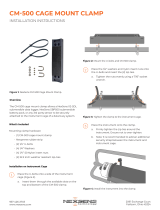
Quick Start Guide
D103214X012
DLC3010 Digital Level Controller
September 2014
7
Table 1. Hazardous Area Classifications—CSA (Canada)
Certification Body Certification Obtained Entity Rating Temperature Code
CSA
Ex ia Intrinsically Safe
Class I,II,III Division 1 GP A,B,C,D,
E,F,G T6 per drawing 28B5744 (see figure 14)
Vmax = 30 VDC
Imax = 226 mA
Ci = 5.5 nF
Li = 0.4 mH
T6 (Tamb ≤ 80°C)
Explosion-proof
Class I, Division 1 GP B,C,D T6
- - - T6 (Tamb ≤ 80°C)
Class I Division 2 GP A,B,C,D T6
Class II Division 1,2 GP E,F,G T6
Class III
- - - T6 (Tamb ≤ 80°C)
FM
Special Conditions of Safe Use
Intrinsically Safe, Explosion‐proof, Non‐incendive, Dust Ignition‐proof
1. This apparatus enclosure contains aluminum and is considered to constitute a potential risk of ignition by impact or
friction. Care must be taken into account during installation and use to prevent impact or friction.
Refer to table 2 for approval information.
Table 2. Hazardous Area Classifications—FM (United States)
Certification Body Certification Obtained Entity Rating Temperature Code
FM
IS Intrinsically Safe
Class I,II,III Division 1 GP A,B,C,D,
E,F,G T5 per drawing 28B5745 (see figure 15)
Vmax = 30 VDC
Imax = 226 mA
Ci = 5.5 nF
Li = 0.4 mH
Pi = 1.4 W
T5 (Tamb ≤ 80°C)
XP Explosion‐proof
Class I Division 1 GP B,C,D T5
NI Non‐incendive
Class I Division 2 GP A,B,C,D T5
DIP Dust Ignition‐proof
Class II Division 1 GP E,F,G T5
S Suitable for Use
Class II, III Division 2 GP F,G
- - - T5 (Tamb ≤ 80°C)
ATEX
Special Conditions for Safe Use
Intrinsically Safe
The apparatus DLC3010 is an intrinsically safe apparatus; it can be mounted in a hazardous area.
The apparatus can only be connected to an intrinsically safe certified equipment and this combination must be
compatible as regards the intrinsically safe rules.
Operating ambient temperature: -40_C to + 80_C
Flameproof
Operating ambient temperature: -40_C to + 80_C
The apparatus must be fitted with a certified Ex d IIC cable entry.




















